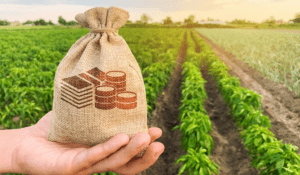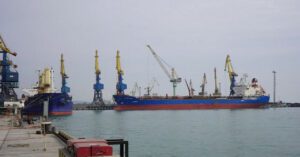
PrJSC Pokrovsky Mining and Processing Plant (PGOK, Dnipropetrovsk region) in January-June of this year saw a net loss of UAH 37.438 million compared to a net profit of UAH 55.980 million a year earlier.
According to the company’s interim report published in the information disclosure system of the National Securities and Stock Market Commission, over this period its net income decreased by 45.3%, to UAH 828.048 million.
Retained earnings by the end of June this year reached UAH 1.366 billion.
Pokrovsky Mining and Processing Plant is the largest producer of manganese ore in Ukraine, which is mining it in an open way.
Four Cypriot companies, namely Profetis Enterprises Limited, Exceed Investmens Limited, Clemente Enterprises Limited and Alexton Holdings Limited own 24.3024% of the shares of the company
The charter capital of the plant is UAH 736.134 million, the par value of the share is UAH 0.25.

The total amount of indirect (indirect) losses inflicted on the agricultural industry of Ukraine as a result of the full-scale invasion of the Russian Federation amounted to $ 23.3 billion for the period from February 24 to June 9, while the country suffered the largest losses (51%) due to the blockade of its seaports to reduce the cost of agricultural products – $ 11.9 billion.
The relevant data was published on Wednesday in the analytical study “Overview of indirect losses from the war in agriculture in Ukraine”, prepared by the Center for Food and Land Use Studies of the Kyiv School of Economics (KSE Institute) in cooperation with the Ministry of Agrarian Policy and Food of Ukraine.
The organization recalled that the day before it presented a study estimating the direct losses of the agro-industrial complex of Ukraine due to Russian aggression at $4.3 billion. According to the document, direct losses reflect the complete or partial destruction of tangible assets, while costs that producers are forced to bear because of the war.
It is noted that half of the indirect losses of the Ukrainian agro-industrial complex fell on the reduction in the cost of agricultural products due to its accumulation in the country caused by the blockade of Ukrainian seaports by the Russian fleet – $ 11.9 billion. Other factors were the reduction in crop production – $ 9.6 billion (43% of total losses) , an increase in the cost of production factors – $ 0.86 billion (4%), a reduction in the livestock sector – $ 0.68 billion (3%) and a reduction in the yield of perennial crops – $ 0.09 billion (> 1%).
“Due to the blockade of ports by the Russian Navy, Ukraine faced an oversaturation of the domestic market of export-oriented products and an almost fourfold increase in the cost of export logistics. This led to a decrease in prices within the country for the main export-oriented crops by more than 30%,” the statement says. in the KSE study.
As an example, the organization cites food wheat, the price of which in Ukraine on the terms of EXW (self-delivery) during the war with the Russian Federation decreased by 35% – from $297/ton to $192/ton, while over the same price period the world price for it increased post twice.
According to the study, the reduction in the wheat crop in 2022 is expected to be 33% compared to the baseline scenario, which corresponds to $2.03 billion of indirect losses, the reduction in the sunflower crop – 32% ($2.43 billion of indirect losses), barley – 31% ($0 .56 billion), corn – 18% ($1.29 billion). Lost income due to a reduction in the harvest of other crops is estimated at about $3.3 billion.
“With the start of the Russian invasion, Ukrainian agricultural producers also faced higher cost of production factors, including higher prices for fertilizers and fuel. The cost of fertilizers has increased by 37% since the beginning of the Russian invasion, while the price of diesel fuel has increased by about $0.39/liter. Total losses due to increased production costs are estimated at $859 million,” KSE stressed in the study.
According to her, the losses due to the reduction in the yield of perennial crops in 2022 are estimated at $89 million. Considering that it takes an average of five years before the fruiting period of new perennial plantations, indirect losses from the destruction of perennial plantations will amount to $222.4 million over five years.
“Calculation of indirect losses helps to understand not only the scale of the industry’s decline, but also the need for a full resumption of production. A significant part of the lost income was used to cover the costs of the subsequent sowing campaign and the purchase of feed for livestock. Without partial compensation for losses, farmers in the regions most affected by war, will not be able to resume production,” KSE quotes its expert Roman Neiter.

Ovostar Union agro-industrial group of companies, one of the leading producers of eggs and egg products in Ukraine, in January-March 2022 received $ 16.44 million in net loss against the Russian military invasion against $ 4.72 million in net profit in the first quarter of 2021, according to the message of the agrarian group on the Warsaw Stock Exchange on Tuesday.
“The egg processing plant in Makarov (Bucha district, Kyiv region) was temporarily shut down until the city was deoccupied by Ukrainian troops in late March. A subsequent inspection of the plant revealed signs of uncritical damage to administrative and industrial buildings … Management expects to resume the operation of the plant after the completion of repair work in the premises, “the company said in a report on the consequences of the Russian invasion.
Ovostar’s revenue in the first quarter of 2022 decreased by 13.7% compared to January-March 2021 – to $ 27.71 million. The gross loss of the group of companies in the first quarter of this year amounted to $ 13.38 million against $ 6.91 million gross profit in January-March 2021, also for this period it received $ 15.67 million in operating loss against $ 4.37 in operating profit last year.
In the structure of Ovostar’s revenue, 75% was accounted for by egg sales ($ 20.8 million), of which 87% ($ 18.1 million) accounted for sales in Ukraine. The egg products segment generated 25% of the agroholding’s revenue ($ 6.8 million), with 58% of its sales ($ 3.93 million) in the domestic market.
“The main sales channel of the egg segment is large national retail chains. Geographically, sales are concentrated in the central part of the country, and the share of sales in the most affected regions does not exceed 10%. Market losses in the east and south where a large number of internally displaced persons temporarily reside, “the Ovostar report said.
The document states that the assets of the agricultural holding as of March 31, 2022 decreased compared to December 31, 2012 by 18.3% to $ 115.3 million, its long-term debt decreased by 1.8 times to $ 5.8 million, and current growth – by 1% to $ 14.5 million
“Since the beginning of the Russian military campaign, the group has faced significant obstacles to export activities due to serious logistics disruptions. In particular, the blockade of the port of Odessa blocked access to Middle Eastern markets, where goods were shipped by sea. after the company was issued a special license, “the egg producer said in a statement.
Ovostar also noted its dependence on imports of certain feed additives, vaccines and spare parts for equipment, which are included in the list of critical imports and are imported into Ukraine without restrictions. The management is also looking for adequate substitutes for imported supplies on the Ukrainian market.
According to the report, as of March 31, 2022, Ovostar Union shares were owned by: Prime One Capital Limited (67.93%), controlled by Ovostar CEO Boris Belikov and Chairman of the Board Vitaly Veresenko; Generali Open Funds Emergency Fund (10.39%), Fairfax Financial Holdings Limited (10.39%), Aviva Open Funds Emergency Fund (5.02%).
Ovostar Union Group is a vertically integrated public holding company, one of the leading producers of chicken eggs and egg products in Europe. The manufacturer is a certified exporter to EU countries since 2015.
The group’s holding company is Ovostar Union N.V. in mid-June 2011 held an IPO of 25% of the shares on the Warsaw Stock Exchange and raised $ 33.2 million. The majority stake in the company is owned by Prime One Capital Limited, which is controlled by its CEO Boris Belikov and Chairman of the Board Vitaly Veresenko.

Today, the Ministry of Infrastructure of Ukraine estimates the losses of port infrastructure from the war with the Russian Federation at tens of billions of hryvnias, but the exact figure will be given only after gaining access to all infrastructure, which is currently located in the temporarily occupied territory.
“The most damaged infrastructure in the Mariupol seaport, there is also damaged infrastructure in the Berdyansk seaport, in the Olvia port, there is some damage in the Chernomorsk seaport, the Nikolaev seaport. But we cannot say exactly the number of damage in ports we do not control, as it is necessary to gain access to this infrastructure. However, today we understand that we are talking about tens of billions of hryvnias, but we will be able to fix the exact figure when we get access to this infrastructure,” Deputy Infrastructure Minister Yuriy said. Vaskov during a briefing at the Ukrainian Media Center on Friday.
He noted that today the seaports of Mariupol, Berdyansk, Skadovsk and Kherson, which are located in the temporarily occupied territory, are closed.
“As for the ports of Pivdenny, Nikolaev, Odessa, Chornomorsk and Belgorod-Dnestrovsk, shipping from these ports is impossible from February 24, so they work exclusively with cargo and fleet, which, as of February 24, February was already under processing. This is 20% activity compared to peacetime,” the deputy minister said.
According to him, the Danube ports (Ust-Danubsky, Izmail and Reni) operate in the usual mode.

The total amount of direct documented damage to Ukraine’s infrastructure as a result of the Russian military invasion has reached almost $88 billion, Head of the President’s Office Andriy Yermak said in a telegram.
“Over the past week, direct losses to the Ukrainian economy due to destruction and damage to civilian and military infrastructure have increased by $3.1 billion,” he wrote, referring to the “Russia will pay” project implemented by the KSE Institute with the support of the Office of the President of Ukraine, the Ministry of Economy, the Ministry of Reintegration and the Ministry of Infrastructure.
Yermak noted that the total losses of the Ukrainian economy – direct and indirect – due to the war range from $564 billion to $600 billion.
“Russia must be responsible for all crimes and destruction in our state, and it is at the expense of the aggressor, in addition to international assistance and money from our budget, that Ukraine must be restored,” the head of the Office of the President of Ukraine stressed.
He clarified that this estimate of the cost of losses from the ongoing war has so far been made only on the basis of public sources.
According to the data he cited, as of today, at least 23 thousand km of roads, 277 bridges and bridge crossings, 11 military airfields, 1 airport have been destroyed or seized.
In addition, 535 kindergartens, 866 institutions of secondary, higher and higher education, 231 medical institutions, 173 factories and enterprises, at least 75 administrative buildings were damaged or destroyed.

The American company Mondelēz International, one of the world’s largest producers of snacks and confectionery, has estimated its losses and additional expenses in the first quarter of 2022 due to the war unleashed by Russia against Ukraine at $143 million (after taxes – $145 million).
“In February 2022, Russia launched a military invasion of Ukraine, and the company closed its operations and facilities in Ukraine. In March 2022, the company’s two Ukrainian production facilities in Trostianets and Vyshgorod were seriously affected,” the company said in a quarterly report on Tuesday evening.
According to him, this amount included $75 million reflected in the impairment of these and other assets and exit costs, $44 million in cost of sales and $24 million in marketing, general and administrative expenses.
As reported, PrJSC Mondelis Ukraine (formerly Kraft Foods Ukraine) is part of the Mondelēz International (USA) group of companies, the holding company of which is Mondelēz Nederland Services B.V (Netherlands).
The company in Ukraine includes the Trostyanets confectionery factory (Sumy region) and a subsidiary company “Chipsy Lux” LLC (Kyiv region).
Since 2003, Mondelis Ukraine has been managing business development in the Moldovan market, since 2005 – in the markets of Belarus, Georgia, Armenia and Azerbaijan, and since 2008 – also in the markets of Kazakhstan, Uzbekistan, Kyrgyzstan, Tajikistan, Turkmenistan and Mongolia.
The company’s business in Ukraine as of autumn last year amounted to more than $400 million. Mondelis Ukraine invested more than $200 million in business development in Ukraine.
“Mondelis Ukraine” sells products under the trademarks “Korona”, Milka, “Vedmedic “Barni”, Tuc, “Belvita! Good Morning!”, “Lux”, Halls, Dirol, Picnic and others.